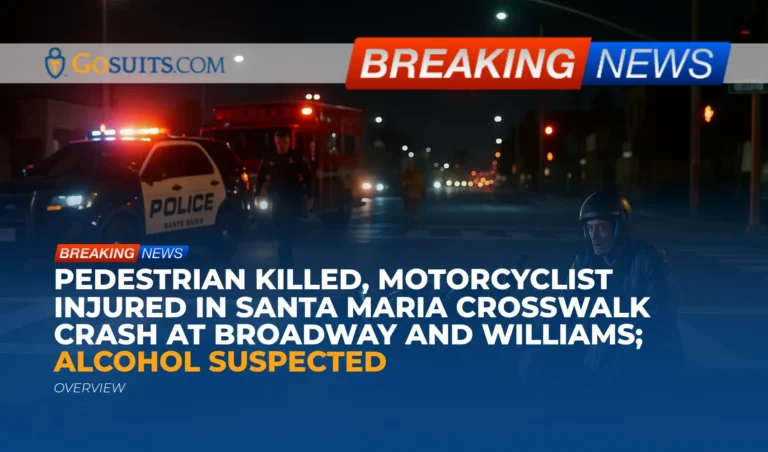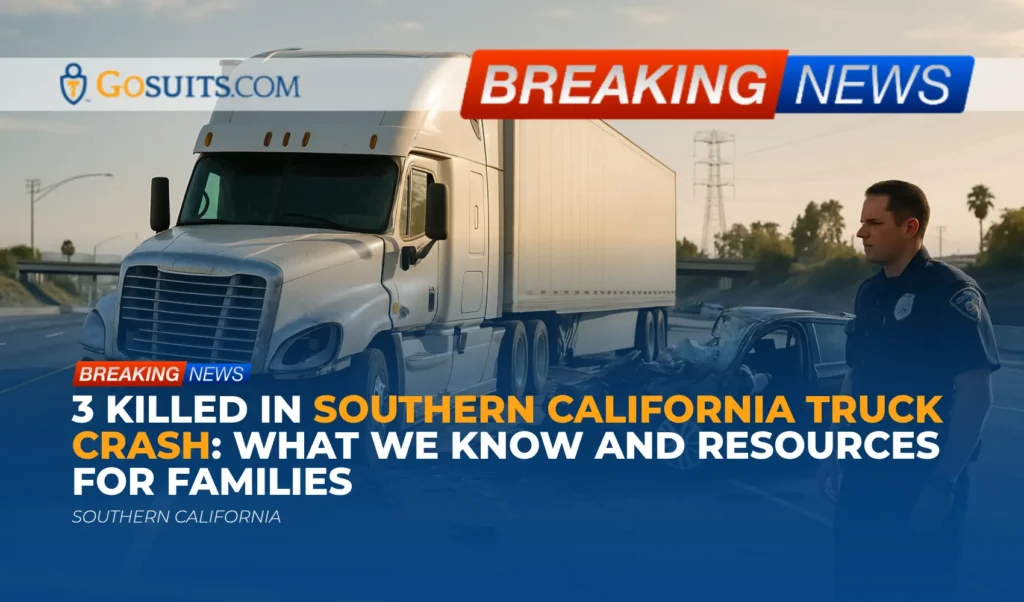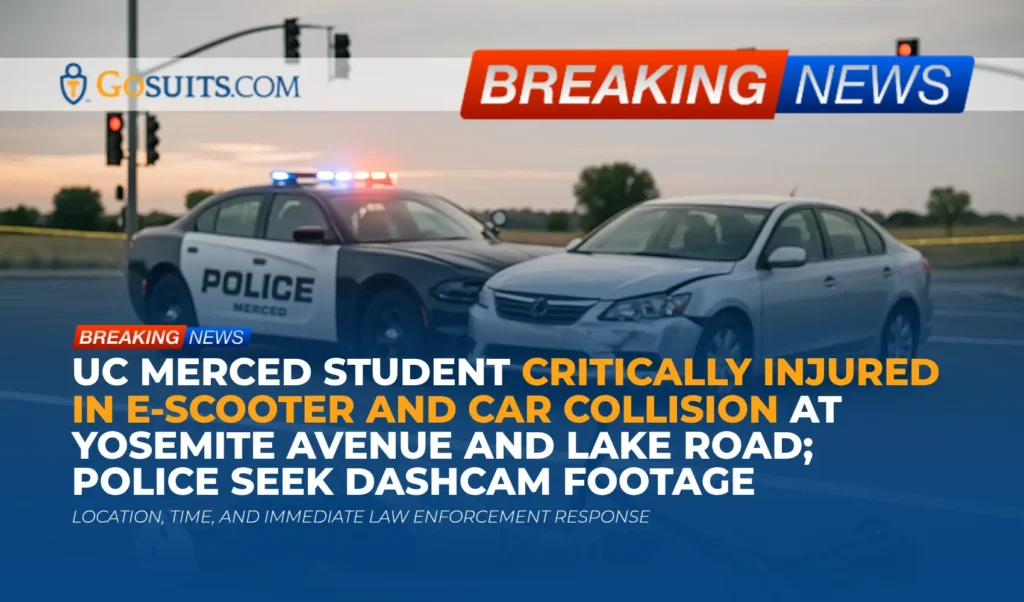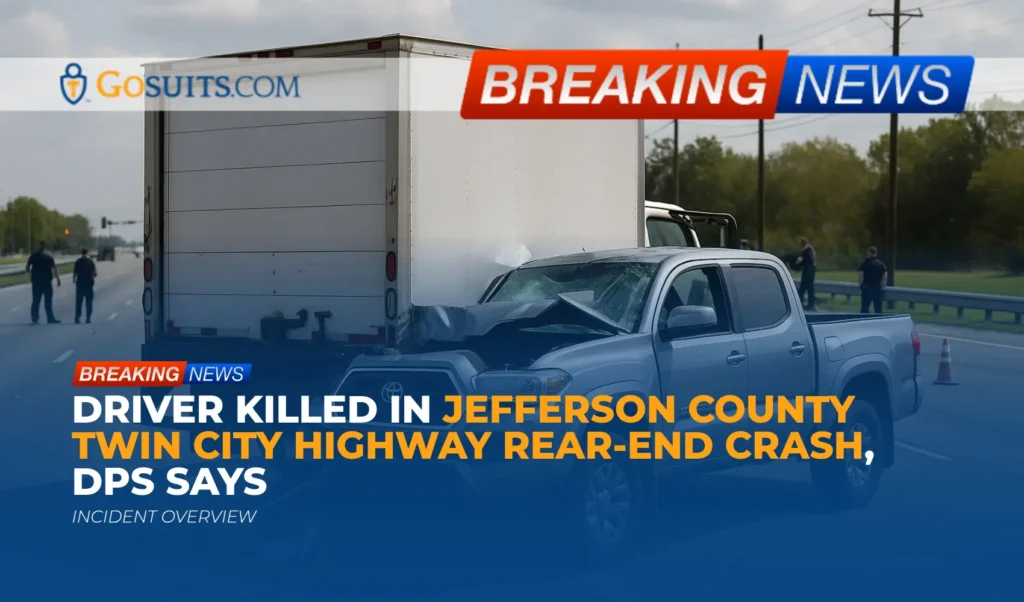- What We Know About the Santa Maria Crosswalk Collision
- Where and When It Happened, and Who Responded
- How Families Can Obtain Key Records and Information
- Crosswalk Right of Way and California Law
- Potential Civil Liability and Insurance Considerations
- The Role of Alcohol or Impairment in Civil Cases
- How Traffic Investigations Typically Proceed After a Fatal Crash
- Community Safety and Engineering Measures That Reduce Risk
- Support Resources for Families and Loved Ones
- Key Time Limits and Deadlines That Often Apply
- Why Taking Action Now Matters
- Commentary from Gosuits Santa Maria, California Personal Injury Attorney
What We Know About the Santa Maria Crosswalk Collision
A severe collision between a motorcycle and a pedestrian occurred in Santa Maria on the evening of October 18. According to information relayed by the Santa Maria Police Department, first responders were dispatched around 8:35 p.m. to the intersection of Broadway and Williams Street. They found a 25-year-old pedestrian and a 32-year-old motorcyclist in the intersection with significant injuries. The pedestrian was crossing eastbound in the north crosswalk of Williams Street when he was struck by a motorcyclist traveling northbound on Broadway. The initial impact threw the pedestrian into the roadway and ejected the motorcyclist from the motorcycle. Both were transported to Marian Regional Medical Center, where the pedestrian tragically passed away. The motorcyclist sustained serious injuries and is receiving treatment.
The Santa Maria Police Department Traffic Unit is investigating, and preliminary findings indicate alcohol may have been a factor. Officials requested that anyone who witnessed the collision or has additional information call Officer Medrano at 805-928-3781, extension 1139.
Our thoughts are with everyone affected. Sudden loss and traumatic injuries upend families and communities. The information below aims to help people understand what typically happens next, what records may be available, how California law views crosswalk crashes, and what steps can support safety, accountability, and healing.
Where and When It Happened, and Who Responded
Time and date: Saturday, October 18, around 8:35 p.m.
Location: Intersection of Broadway and Williams Street, Santa Maria, California.
Responding agencies: Santa Maria Police Department, Santa Maria Fire Department, and emergency medical services. The Traffic Unit of the Santa Maria Police Department is leading the investigation.
Facility of transport: Marian Regional Medical Center.
How Families Can Obtain Key Records and Information
In the aftermath of a fatal traffic collision, families often need information from multiple agencies. The process can feel overwhelming, especially during grief. The following points describe typical channels to request records and assistance. Availability, timing, and release rules vary, and some items may be restricted until the investigation concludes.
Police Traffic Collision Report
The Traffic Unit usually prepares an official traffic collision report. In Santa Maria, that report would come from the Santa Maria Police Department. Families, legal representatives, and insurers commonly request a copy. If the report is not yet ready, the agency may provide an incident number and later release the report when complete. The investigating unit may also collect witness statements, photographs, scene diagrams, and any relevant video.
Contact given by officials: Officer Medrano, Santa Maria Police Department Traffic Unit, 805-928-3781 ext. 1139. Ask for the traffic collision report number and guidance on the release timeline.
Under California’s Public Records framework, some records can be requested by the public, though certain investigative materials may be withheld during an active investigation. Information access is governed by the California Public Records Act in the Government Code. For general reference, see the California Government Code provisions on public records, starting at leginfo.legislature.ca.gov.
Coroner and Autopsy-Related Records
In Santa Maria, coroner functions are handled at the county level. Families may request information regarding cause and manner of death, and in some circumstances, an autopsy report. Depending on county procedure, release may be limited to next of kin or authorized representatives, and toxicology results may be pending for several weeks.
Families can ask the county coroner’s office about available reports, expected timelines, and any forms required to request records. If a death certificate is needed, certified copies can be requested through the California Department of Public Health Vital Records. For state guidance on obtaining certified copies of death records, visit the California Department of Public Health’s site at cdph.ca.gov.
Medical Records
Hospitals generally release medical records to next of kin or authorized representatives. Families can request the decedent’s treatment records from the receiving hospital’s Health Information Management or Medical Records department. These records can be important to understand the nature of the injuries, the care provided, and the timeline of events.
911 Calls, CAD Logs, and Dispatch Audio
Dispatch recordings and call logs can help establish timing and initial observations. These materials are not always retained for long periods, so it is wise to request them promptly. Requests are typically made to the dispatch or records unit of the responding police or fire agency. If retained by a regional dispatch center, that center may have its own request process.
Scene Video and Private Camera Footage
Video can be vital. Potential sources include city traffic cameras, nearby businesses, transit vehicles, and residential doorbell cameras. Many systems overwrite footage quickly, sometimes within days. If possible, ask nearby businesses or residents to preserve any recordings from the date and time of the collision. A written preservation request, sometimes called a spoliation letter, can help notify custodians to save footage.
Insurance Information
Insurance companies for the motorcycle rider and, if applicable, the pedestrian’s own auto policy may become involved. California drivers involved in an injury crash are required to report the incident to the DMV within 10 days using an SR-1 form, see dmv.ca.gov. Before contacting any insurance company for a recorded statement, it is prudent to speak with a qualified attorney for a free consultation. What people say to an insurer can be used later in ways that affect fault determinations and settlement discussions.
Crosswalk Right of Way and California Law
California law requires drivers to yield the right of way to pedestrians crossing within marked crosswalks or within unmarked crosswalks at intersections. See Vehicle Code section 21950 at leginfo.legislature.ca.gov. This duty includes approaching the pedestrian at a safe speed and exercising due care for their safety.
Pedestrians also have duties. Under the same statute, pedestrians must not suddenly leave a curb and walk or run into the path of a vehicle that is so close as to constitute an immediate hazard, and pedestrians must not unnecessarily stop or delay traffic while in a crosswalk. California’s rules aim to emphasize care by both people driving and people walking.
A crosswalk includes any portion of the roadway distinctly indicated for pedestrian crossing, or the extension of sidewalk lines at intersections even if not marked, see the definition at Vehicle Code section 275, leginfo.legislature.ca.gov.
Separate rules govern speed and impairment. California’s basic speed law requires drivers to never drive faster than is safe for conditions, Vehicle Code section 22350. Driving under the influence is prohibited by Vehicle Code section 23152. Links to the Vehicle Code are available at leginfo.legislature.ca.gov.
Potential Civil Liability and Insurance Considerations
The civil law questions in a crosswalk fatality often focus on negligence. Broadly, negligence means a failure to use reasonable care, resulting in harm to another. In a collision, investigators and insurers will examine how each person was acting, visibility and lighting at the time, traffic control devices, speed, impairment, and whether crosswalk and right-of-way rules were followed.
Negligence and Negligence Per Se
When a person violates a safety statute designed to protect a class of people from a type of harm, that violation can be used to establish a presumption of negligence in a civil case. In California, this concept appears in Evidence Code section 669, available at leginfo.legislature.ca.gov. For example, a proven violation of crosswalk right-of-way rules, the basic speed law, or DUI statutes may support a finding of negligence per se if other elements are met in court.

Comparative Fault
California uses a comparative fault system. This means responsibility for damages can be apportioned among the parties based on their respective shares of fault. The Judicial Council’s civil jury instructions explain how juries consider and assign comparative fault, see CACI 405 at courts.ca.gov. Even when one party has the right of way in a crosswalk, investigators may still analyze whether both sides exercised due care under the circumstances.
Wrongful Death and Survival Claims
When a person dies due to another’s negligence, certain family members may bring a wrongful death action under California Code of Civil Procedure section 377.60, see leginfo.legislature.ca.gov. Additionally, a survival action under section 377.30 may allow the decedent’s estate to pursue certain claims the decedent could have brought if they had lived, see leginfo.legislature.ca.gov. These are distinct claims, with different categories of recoverable damages and proof requirements.
Punitive Damages in Egregious Cases
In some cases involving conduct that is found to be malicious, oppressive, or fraudulent, California Civil Code section 3294 permits punitive damages, see leginfo.legislature.ca.gov. Whether punitive damages are available depends on the facts and legal standards that a court applies.
Insurance Coverage Layers
There are several insurance considerations in a pedestrian collision involving a motorcycle.
- Motorcycle liability coverage. California law requires owners to maintain minimum liability insurance limits, see DMV guidance at dmv.ca.gov. Policy limits vary widely. In serious injury or fatal cases, limits may be inadequate to cover losses.
- Uninsured or underinsured motorist coverage. A pedestrian who has their own auto policy may have UM or UIM coverage that can apply to injuries caused by a negligent driver or rider with no insurance or insufficient limits. See consumer resources at the California Department of Insurance, insurance.ca.gov.
- Medical payments coverage. Some policies include MedPay that may help cover medical bills regardless of fault. Terms and coordination of benefits vary by policy.
Before submitting a claim or giving a recorded statement to any insurance adjuster, it is wise to consult with an attorney for a free consultation. Insurers may ask for statements that can later be used to argue comparative fault or to limit the value they assign to a claim.
The Role of Alcohol or Impairment in Civil Cases
Officials indicated that alcohol may have been a factor. Toxicology results and investigative findings will be critical to confirm or rule out impairment. In civil cases, evidence of impairment can be highly significant. If a driver or rider is found to have violated DUI statutes, that violation can support a presumption of negligence under Evidence Code section 669, discussed above.
Impairment increases crash risk and severity. National research repeatedly shows that alcohol use slows reaction time and impairs judgment. See general information from the Centers for Disease Control and Prevention at cdc.gov. The National Highway Traffic Safety Administration also provides pedestrian safety data and strategies at nhtsa.gov.
In a civil claim, the legal questions are about fault, causation, and damages. If impairment is proven, it can weigh heavily in assigning fault. In particularly egregious circumstances, courts may consider punitive damages under Civil Code section 3294, linked above, although that is fact-specific and addressed case by case.
How Traffic Investigations Typically Proceed After a Fatal Crash
A Traffic Unit investigation often includes:
- Scene documentation. Officers measure and photograph the intersection, vehicle resting positions, debris fields, skid or yaw marks, and the location of any visible crosswalk markings. Lighting conditions, traffic signals, and signage are noted.
- Vehicle inspection. Investigators inspect the motorcycle for mechanical defects, brake function, tire condition, lighting, and damage profiles that help reconstruct impact dynamics.
- Witness interviews. Statements from drivers, passengers, pedestrians, and nearby residents or business employees can fill in time and distance details and traffic signal phases.
- Video retrieval. Any available city traffic cameras, private security cameras, and dash cameras are reviewed for corroborating evidence.
- Toxicology. Where impairment is suspected, toxicology testing is conducted pursuant to legal protocols.
- Reconstruction analysis. Using scene data and physics, investigators may estimate speeds, perception-reaction times, and impact angles.
Families are often updated when the report is complete. If the case involves potential civil liability, a separate independent investigation by a retained expert is sometimes conducted to collect additional measurements, perform a visibility study, and obtain statements while memories are fresh.
Community Safety and Engineering Measures That Reduce Risk
Even as investigators work to determine how this collision occurred, it is appropriate to acknowledge broader safety measures that are known to reduce pedestrian risk, especially at night. The Federal Highway Administration has identified a set of Proven Safety Countermeasures that can reduce collisions at intersections and midblocks. See FHWA resources at highways.dot.gov. Examples include:
- High-visibility crosswalks and improved lighting. Better illumination and reflective markings help drivers and riders detect pedestrians earlier.
- Leading pedestrian intervals at signals. Traffic signals can provide pedestrians a head start, improving visibility and reducing conflicts when vehicles begin to move.
- Curb extensions and median refuges. Shortening crossing distances and providing safe waiting areas can improve outcomes on wider roads.
- Speed management. Lower speeds reduce both the likelihood of a collision and the severity of injuries.
While every intersection is unique, these tools reflect practical steps communities can consider to protect people walking and riding. NHTSA’s pedestrian safety materials further underscore the role of visibility, speed, and impairment in outcomes, see nhtsa.gov.
Support Resources for Families and Loved Ones
The period following a sudden loss is incredibly difficult. In addition to leaning on family, friends, and community, the following resources may help.
- California Victim Compensation Board. When a death results from a qualifying crime, certain expenses, such as funeral costs and counseling, may be eligible for assistance through CalVCB. Learn more at victims.ca.gov.
- Mental health and grief support. The SAMHSA National Helpline provides free, confidential 24-hour treatment referral and information at 1-800-662-HELP and samhsa.gov. Local counseling providers and faith or community organizations can also be important supports.
- Death certificates and vital records. Certified copies of death records are typically needed for estate and insurance matters. The California Department of Public Health explains how to obtain them at cdph.ca.gov.
These resources do not replace the personal support of loved ones, but they may help ease certain practical burdens.
Key Time Limits and Deadlines That Often Apply
Time limits can be short in traffic fatality matters. Missing a deadline can affect options later. Some common timeframes include:
- DMV SR-1 accident report. Drivers involved in an injury or fatal collision must file an SR-1 with the DMV within 10 days, see dmv.ca.gov.
- Public entity claims. If a claim might involve a public entity, such as an allegation of a dangerous condition of public property, California Government Code section 911.2 generally requires presentation of a claim within six months of the incident, see leginfo.legislature.ca.gov.
- Wrongful death civil action. In California, the statute of limitations for wrongful death is generally two years from the date of death under Code of Civil Procedure section 335.1, see leginfo.legislature.ca.gov.
Other deadlines may apply depending on the facts and the parties involved. Because claims can involve multiple insurance policies, coordination across different carriers, and potential government claims, timely legal guidance is often important.

Why Taking Action Now Matters
The following steps can preserve options and help ensure that important information is not lost.
- Preserve evidence immediately. Video from nearby businesses, residences, and traffic cameras can be overwritten quickly, sometimes in days. Asking custodians to preserve relevant video and photographs as soon as possible can make a meaningful difference.
- Request key records early. Police reports, dispatch audio, and coroner documents can take time to process. Initiating requests early helps align medical, insurance, and legal needs with agency timelines.
- Coordinate insurance with care. Insurance adjusters will want statements and documentation. Before speaking with any insurer, seek a free consultation with an attorney. Statements to insurers can be used later to challenge fault or the value of losses.
- Track expenses and impacts. Keep receipts and records of funeral costs, counseling, time missed from work, and other related impacts. This information supports any claims that may be made later.
- Know the deadlines. Certain claims have strict timelines, including public entity claims that may have a six-month window. Early planning helps avoid preventable missed deadlines.
Acting now does not mean making final decisions. It means protecting the ability to make informed decisions later with a complete record.
Commentary from Gosuits Santa Maria, California Personal Injury Attorney
We extend our deepest condolences to the family and friends grieving this heartbreaking loss, and we wish a steady recovery to the injured motorcyclist. This article is intended for general information and education about what typically follows a serious traffic collision and how California law addresses these situations.
Based on the information reported by officials, this crash occurred in a crosswalk at night and involved significant forces that led to fatal injuries for the pedestrian and serious injuries for the motorcyclist. Investigators will focus on visibility, speed, traffic controls, and any role of impairment. If alcohol is confirmed, that finding can be highly consequential in determining civil fault and the scope of accountability. At the same time, California’s comparative fault framework requires a careful, fact-specific evaluation of the conduct of everyone involved and the conditions that existed.
In our experience, insurance companies and corporations move quickly to shape the narrative after a serious loss. Adjusters may request recorded statements or offer early settlements before the full picture is known. People often do not realize that the words they choose in a moment of grief or stress can be used later to argue partial fault or to undervalue the human losses that families endure. Important evidence, such as video or electronic data, can also disappear if preservation requests are not made promptly.
A free consultation with a seasoned attorney can help explain rights, outline the steps to protect evidence, and identify all potential sources of coverage. This does not commit anyone to a particular course of action. It provides clarity at a time when clarity is needed, and it helps ensure that decisions are made with a complete understanding of the law, the timeline, and the stakes.
Key Legal and Safety References
California Vehicle Code, crosswalk right of way, section 21950: leginfo.legislature.ca.gov
Definition of crosswalk, section 275: leginfo.legislature.ca.gov
Evidence Code section 669, negligence per se: leginfo.legislature.ca.gov
Wrongful death, Code of Civil Procedure section 377.60, and survival action, section 377.30: leginfo.legislature.ca.gov, leginfo.legislature.ca.gov
Statute of limitations for wrongful death, Code of Civil Procedure section 335.1: leginfo.legislature.ca.gov
California Government Code section 911.2, public entity claim deadlines: leginfo.legislature.ca.gov
DMV SR-1 accident reporting and insurance requirements: dmv.ca.gov, dmv.ca.gov
California Department of Insurance consumer guidance on auto coverage: insurance.ca.gov
CDC impaired driving information: cdc.gov
NHTSA pedestrian safety resources: nhtsa.gov
FHWA Proven Safety Countermeasures: highways.dot.gov
California Department of Public Health vital records, death certificates: cdph.ca.gov
California Victim Compensation Board: victims.ca.gov
SAMHSA National Helpline: samhsa.gov






